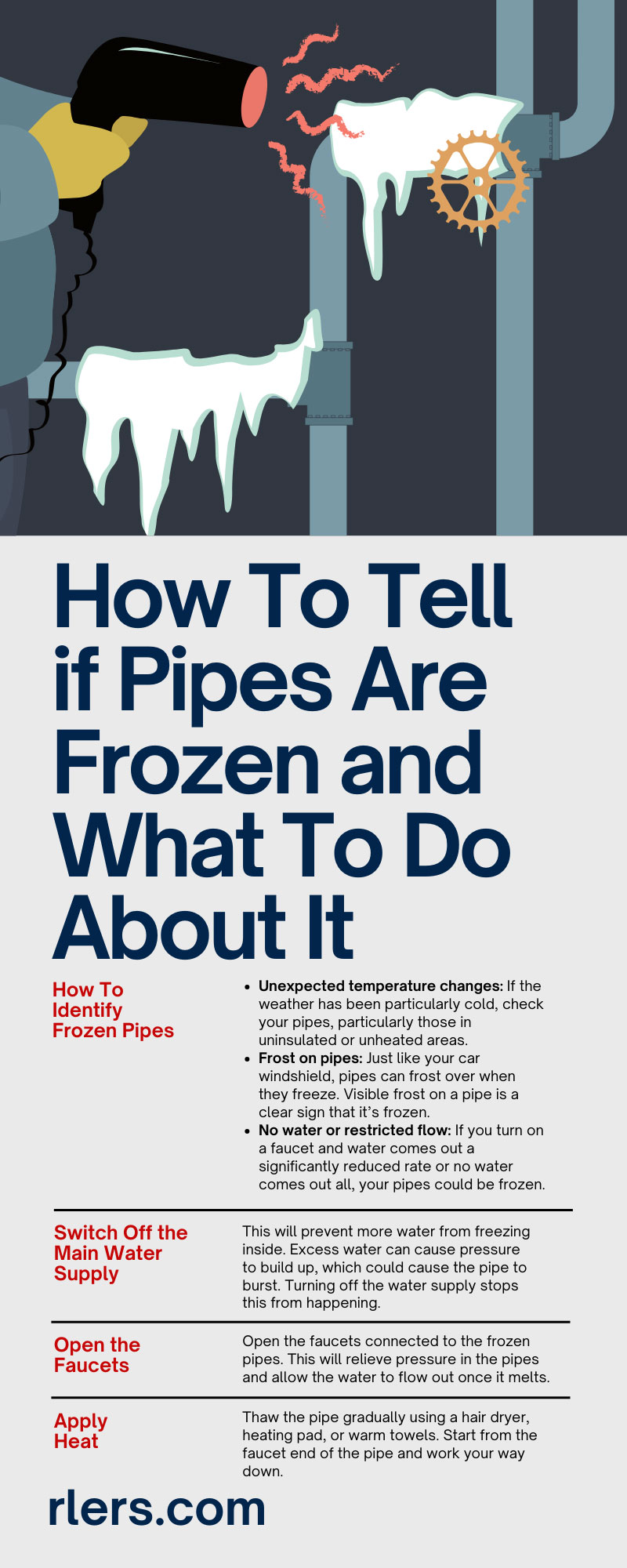
As winter rolls in, and you start to feel the cold, your home’s or business’s plumbing also starts to feel the chill. Freezing pipes is a common and potentially disastrous issue. But don’t panic because knowledge is your first defense.
We’ll guide you through the process of how to tell if pipes are frozen and what to do about it. When you have the correct information and act swiftly, you can avert serious damage to your home or business. Without further ado, let’s dive into the freezing world of winter plumbing woes.
Why Do Pipes Freeze and Why Is This an Issue?
Pipes freeze primarily due to extremely low temperatures. The water inside your pipes can freeze when the thermometer dips and lingers below freezing. This situation is particularly common in pipes that lack sufficient insulation or sit in unheated areas, such as basements, garages, and exterior walls.
Now, why is this an issue? As the water freezes, it expands and puts pressure on the pipes from within. This pressure can cause pipes to burst, leading to significant water damage. Bursting not only disrupts the water supply but also potentially leads to expensive repairs.
How To Identify Frozen Pipes
It’s important to promptly identify the signs of frozen pipes to prevent further damage. Here are several indicators that your pipes may be frozen.
- Unexpected temperature changes: If the weather has been particularly cold, check your pipes, particularly those in uninsulated or unheated areas.
- Frost on pipes: Just like your car windshield, pipes can frost over when they freeze. Visible frost on a pipe is a clear sign that it’s frozen.
- No water or restricted flow: If you turn on a faucet and water comes out a significantly reduced rate or no water comes out all, your pipes could be frozen.
- Odd smells: If your pipes are frozen, a strange smell may come from the faucet or drain. Since ice is blocking the pipe, the odor can’t escape and instead comes back into the house.
- Unusual sounds: You may hear unusual sounds from your pipes, such as clanking, rattling, or bubbling noises.
If you notice any of these signs, you should act swiftly. Delaying action could lead to a burst pipe and significant water damage that you can only mitigate with professional help.
What To Do When Your Pipes Are Frozen
It’s critical to act promptly and correctly when you discover that your pipes are frozen to prevent them from bursting and causing extensive damage. Below is a step-by-step process that you can follow if your pipes are frozen:
Switch Off the Main Water Supply
This will prevent more water from freezing inside. Excess water can cause pressure to build up, which could cause the pipe to burst. Turning off the water supply stops this from happening.
Open the Faucets
Open the faucets connected to the frozen pipes. This will relieve pressure in the pipes and allow the water to flow out once it melts.
Apply Heat
Thaw the pipe gradually using a hair dryer, heating pad, or warm towels. Start from the faucet end of the pipe and work your way down.
Never Use Open Flame
Avoid using an open flame to thaw the pipes, as this could cause further damage or a fire.
Check Other Pipes
Check the rest of the property for more frozen pipes. They often occur in groups, especially in colder areas of the property.
Call a Professional
If you can’t locate the frozen pipe, it’s inaccessible, or your efforts to thaw it don’t work, call a professional plumber to help fix the problem. If your frozen pipe did burst, call a remediation company to remediate any issues or damage.
Remember that the most important thing is to act quickly to reduce the risk of costly damage.
How To Prevent Pipes From Freezing
Preventing pipes from freezing is the best way to avoid the disruption and potential damage that can occur. To save yourself the headache of dealing with frozen pipes, you can employ several strategies to keep the cold at bay.
Insulate Your Pipes
Insulating your pipes, particularly those in unheated areas, can help keep them warm and prevent freezing. You can use pipe insulation materials readily available in home improvement stores.
Let Your Faucets Drip
When temperatures dip below freezing, allow your faucets to drip slightly. This constant water flow can prevent freezing.
Keep Interior Doors Open
Leave interior doors open to allow heat to circulate throughout your home, warming all areas and helping to keep pipes warm.
Seal Any Cracks or Holes
Seal any cracks or holes on your walls, floors, and ceilings that could let cold air in using caulk or spray foam.
Keep the Heat On
Even when you’re not home, keep your heating system on to ensure that the temperature inside your house doesn’t fall below freezing.
Keep in mind prevention is always better than cure. However, if your pipes do freeze despite your best efforts, don’t hesitate to call a professional for help.
Redline Emergency Solutions: Your Go-To Remediation Company
When faced with the unfortunate event of frozen or burst pipes, you may find that the complexity can quickly become overwhelming. Handling such a situation requires an experienced, reliable, and timely response. That’s where Redline Emergency Solutions comes into play.
Providing a full range of services to address water remediation, we commit ourselves to minimizing damage to your property and restoring normalcy as quickly as possible. Our team of professionals has the latest technology and extensive experience handling emergencies related to water damage—whether it’s a burst pipe or a different issue. By choosing Redline Emergency Solutions, you’re choosing peace of mind.
Understanding how to tell if pipes are frozen and what to do about it is crucial, especially during the harsh winter months. Equipping yourself with the proper knowledge and preventive measures can mitigate the risks and impacts of frozen pipes.
Moreover, having a reliable remediation company like Redline Emergency Solutions at your service can provide you with peace of mind and swift assistance when needed. Prevention is key, but quick action is paramount if you find yourself facing frozen pipes. Stay vigilant, informed, and prepared for the winter season.


